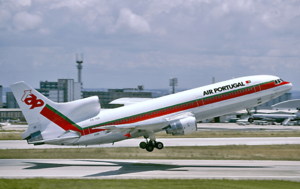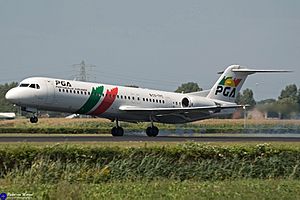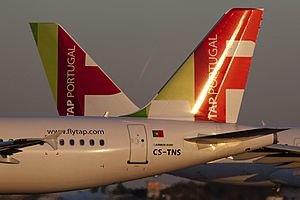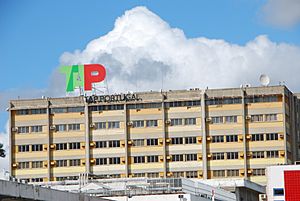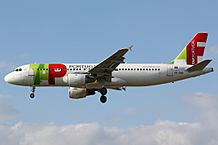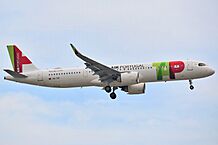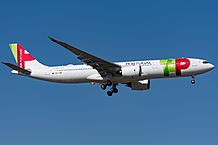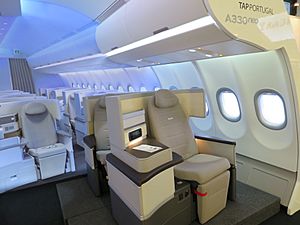TAP Air Portugal facts for kids
A TAP Air Portugal Airbus A330-900
|
|
| Founded | 14 March 1945 (as Transportes Aéreos Portugueses) |
|---|---|
| Commenced operations | 19 September 1946 |
| Hubs | Lisbon Airport |
| Secondary hubs | Porto Airport |
| Focus cities | Madeira Airport |
| Frequent-flyer program | TAP Miles&Go |
| Alliance | Star Alliance |
| Subsidiaries | TAP Express |
| Fleet size | 80 |
| Destinations | 87 (incl. TAP Express) |
| Headquarters | Lisbon, Portugal |
| Key people | Luís Rodrigues |
| Revenue | |
| Operating income | |
| Net income | |
| Total equity | |
| Employees | 6,626 |
TAP Air Portugal is the main airline of Portugal. It is based at Lisbon Airport, which is its main hub. TAP stands for Transportes Aéreos Portugueses, meaning "Portuguese Air Transportation."
Since 2005, TAP Air Portugal has been a part of the Star Alliance, a big group of airlines. It flies about 2,500 flights each week to 90 places in 34 countries around the world. As of May 2019, the airline had 100 aircraft. Most of these planes are made by Airbus. Some smaller planes are made by Embraer and are used by TAP's regional airline, TAP Express.
The airline started on March 14, 1945. Its first flights began on September 19, 1946. TAP was first set up by the government. Over the years, it has been owned by both the government and private companies.
In 1965, TAP bought its first Boeing jet, the Boeing 707. By 1967, it was the first airline in Europe to use only jet planes. In 1979, the airline updated its look and changed its name to TAP Air Portugal. By the end of that decade, it had 32 modern planes flying to over 40 places on four continents.
In the 1980s, older Boeing planes were replaced with Lockheed L-1011 TriStars and Airbus A310s for long flights. For shorter flights, TAP started using Boeing 737-200s in 1983. By the late 1990s, TAP switched to an all-Airbus fleet. This meant it only used planes like the Airbus A319, Airbus A320, Airbus A321, and Airbus A340.
In 2022, the Portuguese government announced plans to sell the airline back to private owners. The Portuguese Court of Audits has often shared concerns about the government's financial support for TAP. Also in 2022, the U.S. Department of Transportation took action against several airlines, including TAP. This was because of very long delays in giving refunds to customers. TAP had to pay $126.5 million in refunds and a $1.1 million penalty.
Contents
A Look at TAP Air Portugal's Journey
How TAP Air Portugal Began
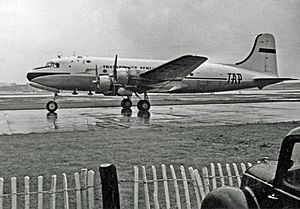
TAP Air Portugal was founded on March 14, 1945. It was first called Transportes Aéreos Portugueses. It was a state-owned company, meaning the government owned it. Later that year, it received its first planes, two Douglas DC-3s.
The airline started its first commercial flights on September 19, 1946. The very first flight went from Lisbon to Madrid with 11 passengers. On December 31, 1946, TAP started its "Linha Aérea Imperial" (Imperial Air Line). This was a long flight with twelve stops, including places like Luanda, Angola, and Maputo, Mozambique. It was one of the longest flights at the time for planes with two engines.
In 1947, TAP started flying within Portugal, with a route between Lisbon and Porto. It also added an international route to London. That same year, the airline bought four Douglas DC-4 Skymasters. These planes were used for flights to Africa and major European cities. In 1948, new flights to Seville and Paris began.
Becoming a Private Company
In 1953, TAP became a private company for the first time. This meant it was no longer fully owned by the government. That same year, it started new flights to Tangier and Casablanca. In late 1955, TAP bought several Lockheed Super Constellation planes. These planes were faster and helped reduce flight times to Africa.
In 1955, TAP made a special long-distance test flight across the Atlantic Ocean to Rio de Janeiro, Brazil. By the end of the 1950s, the airline had carried 64,000 passengers. Its planes had flown 10,000 hours, and its routes covered 14,000 kilometers. TAP also had over 1,000 employees.
In 1960, Rio de Janeiro became TAP's first regular destination in Brazil. This was part of a shared flight service called "Voo da Amizade" (Friendship Flight). In 1961, a new route from Lisbon to Goa was added. This flight took 19 hours and had five stops.
The Age of Jet Planes
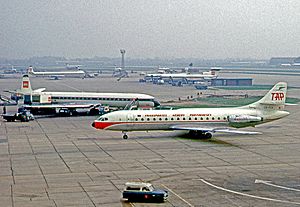
In July 1962, TAP started using jet planes. It bought three Sud Aviation Caravelle jets from France. These jets were first used on the busiest routes in Europe. That same year, new flights started to Las Palmas and Santa Maria Island in the Azores. In 1963, more European routes were added, including to Geneva, Munich, and Frankfurt.
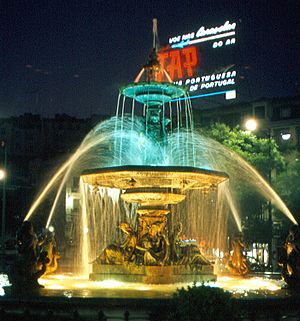
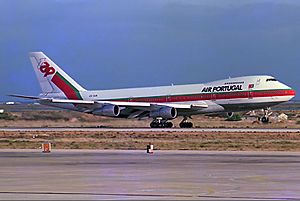
On June 19, 1964, TAP carried its one-millionth passenger. This was about 18 years after it started flying. The next year, TAP bought its first Boeing jet, the Boeing 707. Two years later, it added the shorter-haul Boeing 727. On June 17, 1966, TAP made its first solo flight to Brazil. This flight landed in Rio de Janeiro at the exact same time and day that a historic hydroplane landed there in 1922.
In 1967, TAP became the first European airline to use only jet planes. In 1969, flights to New York City started, with a stop at Santa Maria Island. Two years later, Boston was added to the New York service. In 1971, the airline moved its main office to Lisbon Airport. The next year, TAP received its first Boeing 747-200s. By the end of the 1970s, the airline had 32 modern planes flying to over 40 places on four continents.
In 1974, TAP introduced a new computer system called Tapmatic. This system helped with booking flights, managing luggage, and checking in passengers. By the end of 1974, TAP had carried more than 1.5 million passengers. It had flown 68,210 hours and had a staff of over 9,000 people.
Becoming a State-Owned Company Again
After a big change in Portugal in 1974, many companies became owned by the government. TAP became a state-owned company in 1975.
After Angola and Mozambique became independent, fewer people flew to Africa. Because of this, two of TAP's 747 planes were sold in 1976. In 1979, the airline started a plan to update its brand. Its name changed to TAP Air Portugal, which was easier for people around the world to remember.
Modernizing and Growing the Fleet
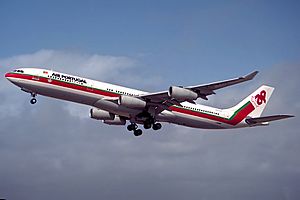
In 1980, TAP started a new flight between Lisbon and Barcelona. It also added more flights between Milan and Rome. In 1981, Teresa Carvalho became the airline's first female pilot. That same year, TAP launched its first in-flight magazine, Atlantis. In 1985, the airline carried two million passengers in one year for the first time. A museum about the airline also opened on March 14, 1985, for its 40th birthday.
In the 1980s, older Boeing 707s and Boeing 747s were replaced. For long flights, TAP used Lockheed L-1011 TriStars and Airbus A310s. In 1983, TAP started using its first Boeing 737-200s for shorter flights. In 1988, it launched a new system for calculating fares and printing tickets. It also became the first airline to use satellite connections for communication between planes and the ground.
In 1985, TAP created a special company called Air Atlantis for holiday flights. This company used Boeing 707, 727, and 737 jets.
In 1991, the airline carried three million passengers in one year for the first time. In 1993, TAP started flying to Tel Aviv. In 1994, TAP worked with Delta Air Lines for flights across the North Atlantic. This agreement ended in 2005. In 1996, flights to Boston (with a stop at Terceira Island) and Macau began. TAP also launched its website that year. In 1997, flights to Punta Cana and Bangkok started, but flights to Bangkok and Macau stopped the next year.
By the late 1990s, TAP updated its fleet by selling its older Boeing 727s and 737s. It replaced them with Airbus planes like the Airbus A319, Airbus A320, and Airbus A321. Its TriStars were also replaced with Airbus A340s starting in 1995. These changes made TAP an airline that only used Airbus planes. This made its fleet more efficient. In 1999, TAP started its first "Blue Flights," where smoking was not allowed.
In 1997, TAP and Swissair formed a partnership. As part of this, Swissair was supposed to buy a part of TAP. TAP also joined Qualiflyer, Swissair's frequent-flyer program. However, Swissair faced money problems and did not buy the shares. This caused problems for TAP.
The 21st Century Begins
In February 2005, TAP Air Portugal changed its name to TAP Portugal. On March 14, 2005, TAP joined the Star Alliance, a big group of airlines. This was also the airline's 60th anniversary. TAP also ended its agreement with Delta Air Lines and started a new one with United Airlines as part of its Star Alliance membership.
In 2006, TAP Portugal bought almost all of the regional airline Portugália Airlines. It also started an agreement with US Airways for flights between Portugal and the United States.
In 2007, NATO recognized TAP Portugal for its excellent engine and aircraft repair work. TAP Portugal has large maintenance centers in Lisbon, Portugal, and in Rio de Janeiro and Porto Alegre, Brazil. It also has smaller repair stations in other countries. In June 2009, it started regular flights to Moscow, Warsaw, and Helsinki.
In 2008, TAP changed its booking and inventory systems to the Altéa system, managed by Amadeus IT Group. Before this, TAP used a system called Tapmatic, which had been in use since 1972.
In 2010, TAP added two new routes to Africa: Marrakesh and Algiers. These new routes showed that the airline wanted to grow more in Africa. Since 2001, the number of passengers flying to Africa with TAP had increased by over 129%. In 2011, new long-distance flights to Miami and Porto Alegre were added.
Changes in Ownership
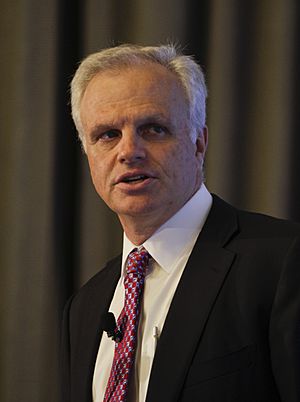
To get financial help from the government during a difficult time, Portugal had to sell its shares in several companies, including TAP. Many international companies were interested in buying the airline. In October 2012, the Portuguese government announced that Synergy Group, which owns the airline Avianca, was the only potential buyer.
In March 2014, TAP announced it would buy two ATR 42-600 planes for its subsidiary Portugália Airlines. These planes replaced smaller ones used by PGA Express.
The Portuguese government planned to sell most of its shares in TAP again in 2014. It wanted to sell 66% of the airline, with 5% set aside for its 7,500 employees. Several groups were interested in buying, including German Efromovich, Frank Lorenzo with Miguel Pais do Amaral, David Neeleman, and Globalia (owner of Air Europa).
In May 2015, a pilot strike lasted over a week. This caused about 3,000 TAP Air Portugal flights to be canceled.
In June 2015, the Portuguese government decided to sell the TAP Air Portugal Group to the Atlantic Gateway group. This group, formed by David Neeleman and Humberto Pedrosa, took control of 61% of the airline. As part of the deal, TAP Air Portugal had to keep Lisbon as its main hub for at least 30 years. The new owners also promised to buy 53 new Airbus planes for the airline.
Becoming State-Owned Again
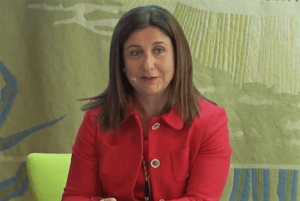
In October 2015, a new government wanted the state to own most of the airline again. In February 2016, a deal was signed. This deal stated that the Portuguese government owned 50% of the company. The Atlantic Gateway group owned 45%, and 5% of shares were for TAP employees.
On January 14, 2016, TAP Air Portugal announced that its subsidiary Portugália Airlines would be renamed TAP Express. This change happened on March 27, 2016, as part of a plan to reorganize the group. TAP also announced that all Portugália planes would be replaced with new ones by July 2016. These new planes would have a similar design to TAP Air Portugal's. The airline also stopped some long-haul flights to places like Panama City and Bogota, and some European flights.
TAP Air Portugal wanted to promote Portugal as a place for tourists from the United States. It also wanted Lisbon to be a gateway to Europe for North American travelers. In February 2016, it announced that non-stop daily flights from Lisbon to New York's John F. Kennedy International and Boston's Logan International would return. The Boston service started on June 11, and the new JFK flights started on July 1. Both used new Airbus A330-200s. These new routes increased TAP Air Portugal's flights to the US to 30 per week.
TAP expanded its network in 2017, adding 10 new routes. Some of these had been flown by the airline before. New destinations included Abidjan, Ivory Coast; Alicante and Las Palmas, Spain; Bucharest, Romania; Budapest, Hungary; Cologne and Stuttgart, Germany; Fez, Morocco; Lomé, Togo; London City Airport, United Kingdom; and Toronto, Canada.
In March 2017, Miguel Antunes Frasquilho was chosen to be TAP Air Portugal's new chairman.
On September 14, 2017, TAP Portugal changed its name back to TAP Air Portugal. This was the name it used between 1979 and 2005.
In 2020, during the COVID-19 Crisis, the Portuguese government received approval to help the airline financially. This included a loan of €1.2 billion to help it through the crisis. A plan was also made to reorganize the company, which involved reducing the number of employees and selling some aircraft.
On November 14, 2022, the U.S. Department of Transportation announced actions against six airlines, including TAP. This was for very long delays in giving refunds. TAP had to pay $126.5 million in refunds and a $1.1 million penalty.
Plans to Become Private Again
In September 2022, the Portuguese government announced it wants to sell the company to private owners again. They are waiting for the right time in the market to do this. The government hopes to complete the sale by the first half of 2023. The previous decision to make TAP state-owned again was a big promise from the government. They argued that TAP was important for the country's economy and should be public.
However, the Portuguese Court of Audits strongly disagreed with the government owning TAP. They said it would not be efficient and would cost taxpayers millions of euros. The government put €337.5 million directly into TAP and guaranteed €615 million in debts for the company.
In October 2022, the Portuguese Court of Audits again criticized the money put into TAP by taxpayers. They said it should have been counted as an expense, not an asset. They believed it was an unprofitable public investment that could put the country's debt at risk.
Former Portuguese Infrastructure Minister Pedro Nuno Santos resigned on December 29, 2022. This happened after public concern about a large payment made to a former TAP executive. On March 6, 2023, the Portuguese government removed the airline's Chief Executive Officer (CEO) and Chairman. This followed a report from the Portuguese General Inspectorate of Finances.
On February 28, 2025, during a visit by French President Emmanuel Macron to Portugal, Air France-KLM announced its interest in buying a 49% share of TAP. Lufthansa and IAG also plan to bid.
How TAP Air Portugal Works
Business Information
Here are some key facts about TAP Air Portugal, including TAP Express, up to the end of 2023:
| Revenue (€m) |
Net profit (€m) |
Number of employees |
Number of passengers (m) |
Passenger load factor (%) |
Number of destinations |
Operating fleet |
Notes/ references |
|
|---|---|---|---|---|---|---|---|---|
| 2015 | 2,598 | −152 | 11,023 | 11.3 | 80.3 | 84 | 61 | |
| 2016 | 2,338 | −23 | 11,019 | 11.6 | 79.8 | 75 | 63 | |
| 2017 | 2,978 | 23 | 10,881 | 14.2 | 82.9 | 85 | 88 | |
| 2018 | 3,177 | −58 | 8,145 | 15.7 | 81.0 | 91 | 96 | |
| 2019 | 3,299 | −96 | 9,006 | 17.0 | 80.1 | 95 | 105 | |
| 2020 | 1,060 | −1,230 | 8,106 | 4.6 | 64.6 | 88 | 96 | |
| 2021 | 1,389 | −1,599 | 6,626 | 5.8 | 63.0 | 88 | 94 | |
| 2022 | 3,485 | 65 | 6,988 | 13.7 | 80.0 | 90 | 93 | |
| 2023 | 4,214 | 177 | 7,558 | 15.9 | 80.8 | 88 | 98 | |
| 2024 | 4,242 | 53.7 | 7,900 | 16.1 | 82.3 | 86 | 99 |
Main Office
TAP's main office is in Building 25 at Lisbon Airport in Santa Maria dos Olivais, Lisbon.
Other Companies TAP Owns
TAP Air Portugal has several other companies it owns:
Until the end of 2016, TAP Air Portugal owned 51% of Lojas Francas de Portugal (LFP). This company runs duty-free shops in airports and on TAP flights. TAP sold its share in LFP to Vinci SA, which owns ANA Aeroportos de Portugal.
TAP Cargo
TAP Cargo is the part of TAP Air Portugal that handles air freight. It does not have its own cargo planes. Instead, it sells space for cargo on TAP's passenger flights. It also has five regular all-cargo routes using planes from other airlines.
Branding and How TAP Presents Itself
On February 28, 2011, TAP started its "TAP With Arms Wide Open" campaign. This campaign featured a new slogan and a music video. The video included singers from Brazil, Portugal, and Angola, along with TAP employees. This showed the connection between Portuguese-speaking countries.
In 2005, TAP revealed its current logo and plane design. This was to celebrate its 60th anniversary and joining the Star Alliance. At that time, the name changed from TAP Air Portugal to TAP Portugal. On September 14, 2017, the airline went back to its previous name, TAP Air Portugal. The first logo from 1945 had a blue wing with "TAP" written next to it.
TAP Museum
The TAP museum started in 1978 and officially opened on March 14, 1985. This was part of the company's 40th-anniversary celebrations. It was first located at the company's main office in Lisbon. On January 29, 2010, a new, larger museum opened in Sintra. This museum is a partnership between the airport operator, the Portuguese Air Force, and TAP. It shows the history of military and civil aviation in Portugal. Visitors can see 40 aircraft, including a TAP Douglas DC-3, along with simulators and engines.
Awards TAP Air Portugal Has Won
In 2007, NATO recognized TAP Air Portugal as the best place for engine and aircraft repair for their AWACS Maintenance Program. TAP Air Portugal has also received top awards from Airbus Industries for its maintenance work in 1996, 2000, 2003, and 2005. It is certified by important groups like the FAA and EASA.
In 2010, British Condé Nast Traveler magazine named TAP Air Portugal the "World's Best Airline." It was also named the "Best Airline to South America" by the World Travel Awards in 2009 and 2010. TAP Air Portugal has often received high rankings and awards from other travel publications. In recent years, the World Travel Awards (WTA) has repeatedly chosen TAP Air Portugal as the World's Leading Airline to Africa and South America. The WTA awards are sometimes called the "Oscars" of the travel industry.
In late 2017, Monocle magazine's Travel Top 50 list gave TAP Air Portugal the award for "most handsome crew."
Where TAP Air Portugal Flies
As of June 2017, TAP Air Portugal flies to 87 places in 34 countries. These include destinations in Europe, Africa, North America, and South America. Some flights within Portugal, Europe, and Africa are operated by TAP Express.
TAP Air Portugal is the top European airline flying to Brazil. It offers more flights from its Lisbon hub to Brazil than any other European airline. Many Europeans travel through Portugal to fly to Brazil because TAP has many flight times available to that country.
In March 2016, TAP Air Portugal started a special shuttle service called "Ponte Aérea" (Air Bridge). This service connects Lisbon and Porto airports with flights every hour, totaling 18 round-trip flights. White Airways operates this service for TAP Express. As of 2019, TAP Air Portugal planned to launch 15 new routes and receive 15 new aircraft.
TAP Air Portugal has agreements to share flights with these airlines:
- Aegean Airlines
- airBaltic
- Air Canada
- Air China
- Air India
- All Nippon Airways
- Austrian Airlines
- Azores Airlines
- Azul Brazilian Airlines
- Beijing Capital Airlines
- Brussels Airlines
- Croatia Airlines
- Egyptair
- El Al
- Emirates
- Ethiopian Airlines
- Etihad Airways
- Finnair
- Gol Transportes Aéreos
- Icelandair
- ITA Airways
- JetBlue
- LATAM Brasil
- LAM Mozambique Airlines
- LOT Polish Airlines
- Lufthansa
- Luxair
- Nordica
- S7 Airlines
- Singapore Airlines
- South African Airways
- Swiss International Air Lines
- Thai Airways International
- Turkish Airlines
- United Airlines
TAP Air Portugal's Planes
Current Planes
As of March 2025, TAP Air Portugal uses only Airbus planes. Here are the types of aircraft it operates:
| Aircraft | In service | Orders | Passengers | Notes | ||||
|---|---|---|---|---|---|---|---|---|
| B | W | Y | Total | Refs | ||||
| Airbus A319-100 | 5 | — | — | — | 144 | 144 | ||
| Airbus A320-200 | 15 | — | — | — | 174 | 174 | ||
| Airbus A320neo | 12 | 14 | — | — | 174 | 174 | ||
| Airbus A321-200 | 3 | — | — | — | 216 | 216 | ||
| Airbus A321LR | 13 | — | 16 | 42 | 113 | 171 | ||
| Airbus A321neo | 23 | 8 | 16 | — | 182 | 198 | ||
| — | 216 | 216 | ||||||
| 221 | 221 | |||||||
| Airbus A330-200 | 3 | — | 25 | — | 244 | 269 | ||
| Airbus A330-900 | 19 | 2 | 34 | 96 | 168 | 298 | Launch customer. | |
| Total | 93 | 24 | ||||||
New Plane Development
TAP Air Portugal was the first airline to use the Airbus A330neo. Airbus delivered the first one to TAP in November 2018. TAP ordered 21 of these planes. As of September 2018, TAP expected to have 133 aircraft in its fleet by 2025, including those for TAP Express.
Past Planes TAP Has Used
Before its current fleet, TAP Air Portugal used these types of aircraft:
| Aircraft | Introduced | Retired | Refs |
|---|---|---|---|
| Airbus A310-300 | 1988 | 2008 | |
| Airbus A330-300 | 2017 | 2019 | |
| Airbus A340-300 | 1995 | 2019 | |
| Beechcraft E90 King Air | 1979 | 1984 | |
| Beechcraft Baron 58 | 1975 | 1979 | |
| Boeing 707-382B | 1965 | 1989 | |
| Boeing 727-100 | 1967 | 1989 | |
| Boeing 727-200 | 1975 | 1991 | |
| Boeing 737-200 | 1983 | 1999 | |
| Boeing 737-300 | 1988 | 2001 | |
| Boeing 747-282B | 1972 | 1984 | |
| de Havilland Canada DHC-6 Twin Otter | 1979 | 1987 | |
| Douglas DC-3 | 1945 | 1959 | |
| Douglas DC-4 | 1947 | 1960 | |
| Lockheed L-1011 TriStar | 1983 | 1997 | |
| Lockheed L-1049 Super Constellation | 1953 | 1967 | |
| Sud Aviation Caravelle | 1962 | 1969 |
Services on Board
Airport Lounges
TAP Air Portugal has two different lounges at Lisbon Airport. The TAP Premium Lounge is for special members and business class passengers. The Blue Lounge is for other members and is managed by Groundforce Portugal.
Cabin Classes
TAP Air Portugal planes have two main types of seating: business class (called tap|executive) and economy class (with options like tap|plus, tap|classic, tap|basic, and tap|discount). TAP does not offer first-class service.
On shorter and medium flights, the Airbus A319, A320, and Airbus A321 planes have new leather seats. Business class offers more privacy and food choices than economy.
On long-haul flights with Airbus A330, A330neo, and A321LR planes, the economy class has modern screens with touchscreens for movies and games. The older Airbus A340 economy class was updated in 2013 with new seats and entertainment. In business class, seats can turn into flat beds. New Airbus A330 planes also have extra features.
TAP's in-flight magazine is called UP. You can read it on the plane, on a website, or as an app for tablets.
Airspace by Airbus
TAP Air Portugal is also one of the first airlines to use a new cabin design called "Airspace." This design allows airlines to fit more seats on the plane.
Frequent Flyer Program
TAP Air Portugal's current loyalty program is called Miles & Go. It replaced an older program called Victoria. In this program, members earn miles based on how far they fly, the ticket price, and their class of service.
Since TAP is part of Star Alliance, you can earn miles when flying with other Star Alliance airlines. Joining the Miles&Go program is free. The program has three levels:
- The basic level, which has no mileage requirements.
- TAP Miles&Go Silver (Star Alliance Silver), which requires 30,000 Status Miles or 25 flights in one year.
- TAP Miles&Go Gold (Star Alliance Gold), which requires 70,000 Status Miles or 50 flights in one year.
Safety Information
According to a report from January 2021, TAP ranks 22nd among the 100 largest airlines for safety.
- On January 27, 1948, a Douglas C-47A plane was on a training flight near Lisbon in bad weather. The plane lost control and crashed, and all 3 people on board died.
- TAP Air Portugal Flight 425: On November 19, 1977, Flight 425 crashed at Madeira Airport. This was TAP's most serious accident. The Boeing 727 was trying to land in heavy rain. The pilot tried to land twice but couldn't. On the third try, the plane landed too late and went off the end of the runway. The runway was only 1,600 meters long at the time. The plane crashed onto a beach, broke into two pieces, and caught fire. Out of 164 people on board, 131 died, and 33 survived. This accident led to plans to make the runway at Madeira longer. A 200-meter extension was built between 1983 and 1986. In 2000, the runway was made even longer, to 2,781 meters. This allowed larger planes like the Boeing 747 and Airbus A340 to land there.
- TAP Air Portugal Flight 1492: On September 2, 2022, an Airbus A320 plane (Flight 1492) hit a motorcycle that crossed the runway at Ahmed Sékou Touré International Airport in Conakry, Guinea. This happened as the plane was landing. Both people on the motorcycle died, but everyone on the plane was safe. The plane's engine was damaged.
See also
 In Spanish: TAP Air Portugal para niños
In Spanish: TAP Air Portugal para niños


